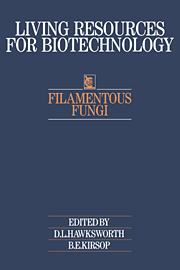Book contents
- Frontmatter
- Contents
- Contributors
- Series introduction
- Preface
- Acknowledgements
- 1 Resource centres
- 2 Information resources
- 3 Administration and safety
- 4 Culture and preservation
- 5 Identification
- 6 Patent protection for biotechnological inventions
- 7 Culture collection services
- 8 Organisation of resource centres
- Appendix: Media
- References
- Index
6 - Patent protection for biotechnological inventions
Published online by Cambridge University Press: 04 August 2010
- Frontmatter
- Contents
- Contributors
- Series introduction
- Preface
- Acknowledgements
- 1 Resource centres
- 2 Information resources
- 3 Administration and safety
- 4 Culture and preservation
- 5 Identification
- 6 Patent protection for biotechnological inventions
- 7 Culture collection services
- 8 Organisation of resource centres
- Appendix: Media
- References
- Index
Summary
Introduction
This chapter is intended to give the reader who is unfamiliar with patents an introduction to the patent system as it applies to biotechnology, and a general guide to the procedures and pitfalls involved in obtaining patent protection for biotechnological inventions. For a detailed discussion of the whole subject of patents in biotechnology and a review of the variety of national patent systems the reader is referred to the excellent texts by Crespi (1982), Beier, Crespi & Straus (1985) and Straus (1985). It is not possible here to provide a step-by-step guide to getting a patent in every country in the world, for, despite an overall similarity, variations between different national patent laws are manifold, and professional help is necessary to guide even the experienced inventor through their complexities. The present account does no more than skim the surface of what is a complex and often fascinating subject; for this reason a short list of selected publications which illustrate in more detail many of the points raised here is given in Section 6.6, Further reading.
Basis of the patent system
Principles
The principle (if not the practice) of the patent system is straightforward: the inventor of a new product or process publicly discloses the details of his invention and in return he is granted for a limited period a legally enforceable right to exclude others from exploiting it. In this way the inventor's ingenuity is acknowledged and rewarded, while at the same time further technical progress is encouraged by the public dissemination of information about the invention.
- Type
- Chapter
- Information
- Filamentous Fungi , pp. 115 - 161Publisher: Cambridge University PressPrint publication year: 1988
- 4
- Cited by



